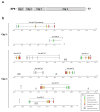Genomic organisation analysis of novel immunoglobulin-like transcripts in Atlantic salmon (Salmo salar) reveals a tightly clustered and multigene family
- PMID: 21143889
- PMCID: PMC3022915
- DOI: 10.1186/1471-2164-11-697
Genomic organisation analysis of novel immunoglobulin-like transcripts in Atlantic salmon (Salmo salar) reveals a tightly clustered and multigene family
Abstract
Background: Several novel immunoglobulin-like transcripts (NILTs) which have previously been identified in the salmonid species rainbow trout (Oncorhynchus mykiss) contain either one or two extracellular Ig domains of the V-type. NILTs also possess either an immunoreceptor tyrosine-based activating motif (ITAM) or immunoreceptor tyrosine-based inhibitory motifs (ITIMs) in the cytoplasmic region resulting in different signalling abilities. Here we report for the first time the genomic organisation and structure of the multigene family of NILTs in Atlantic salmon (Salmo salar) using a BAC sequencing approach.
Results: We have identified six novel Atlantic salmon NILT genes (Ssa-NILT1-6), two pseudogenes (Ssa-NILTp1 and Ssa-NILTp2) and seven genes encoding putative transposable elements in one BAC covering more than 200 kbp. Ssa-NILT1, 2, 4, 5 and 6 contain one Ig domain, all having a CX₃C motif, whereas Ssa-NILT3 contains two Ig domains, having a CX₆C motif in Ig1 and a CX₇C motif in Ig2. Atlantic salmon NILTs possess several ITIMs in the cytoplasmic region and the ITIM-bearing exons are in phase 0. A comparison of identity between the amino acid sequences of the CX₃C Ig domains from NILTs varies from 77% to 96%. Ssa-NILT1, 2, 3 and 4 were all confirmed to be expressed either by their presence in EST databases (Ssa-NILT1) or RT-PCR (Ssa-NILT2, 3, and 4) using cDNA as template. A survey of the repertoire of putative NILT genes in a single individual revealed three novel genes (Ssa-NILT7-9) represented by the Ig domain, which together with Ig domains from Ssa-NILT1-6 could be divided into different groups based on specific motifs.
Conclusions: This report reveals a tightly clustered, multigene NILT family in Atlantic salmon. By screening a highly redundant Atlantic salmon BAC library we have identified and characterised the genomic organisation of six genes encoding NILT receptors. The genes show similar characteristics to NILTs previously identified in rainbow trout, having highly conserved cysteines in the Ig domain and several inhibitory signalling motifs in the cytoplasmic region. In a single individual three unique NILT Ig domain sequences were discovered at the genomic DNA level, which were divided into two different groups based on a four residue motif after the third cysteine. Our results from the BAC screening and analysis on the repertoire of NILT genes in a single individual indicates that many genes of this expanding Ig containing NILT family are still to be discovered in fish.
Figures






Similar articles
-
A highly diverse set of novel immunoglobulin-like transcript (NILT) genes in zebrafish indicates a wide range of functions with complex relationships to mammalian receptors.Immunogenetics. 2023 Feb;75(1):53-69. doi: 10.1007/s00251-022-01270-9. Epub 2022 Jul 23. Immunogenetics. 2023. PMID: 35869336 Free PMC article.
-
Novel immunoglobulin-like transcripts in teleost fish encode polymorphic receptors with cytoplasmic ITAM or ITIM and a new structural Ig domain similar to the natural cytotoxicity receptor NKp44.Immunogenetics. 2005 Apr;57(1-2):77-89. doi: 10.1007/s00251-005-0771-9. Epub 2005 Feb 9. Immunogenetics. 2005. PMID: 15702329
-
Rainbow trout (Oncorhynchus mykiss) possess multiple novel immunoglobulin-like transcripts containing either an ITAM or ITIMs.Dev Comp Immunol. 2009 Apr;33(4):525-32. doi: 10.1016/j.dci.2008.10.002. Epub 2008 Nov 12. Dev Comp Immunol. 2009. PMID: 19013192
-
Immunoglobulin isotypes in Atlantic salmon, Salmo salar.Biomolecules. 2015 Feb 27;5(1):166-77. doi: 10.3390/biom5010166. Biomolecules. 2015. PMID: 25734583 Free PMC article. Review.
-
An Illumina approach to MHC typing of Atlantic salmon.Immunogenetics. 2020 Feb;72(1-2):89-100. doi: 10.1007/s00251-019-01143-8. Epub 2019 Nov 12. Immunogenetics. 2020. PMID: 31713647 Free PMC article. Review.
Cited by
-
Multigene families of immunoglobulin domain-containing innate immune receptors in zebrafish: deciphering the differences.Dev Comp Immunol. 2014 Sep;46(1):24-34. doi: 10.1016/j.dci.2014.02.004. Epub 2014 Feb 15. Dev Comp Immunol. 2014. PMID: 24548770 Free PMC article. Review.
-
Analysis of genome survey sequences and SSR marker development for Siamese Mud Carp, Henicorhynchus siamensis, using 454 pyrosequencing.Int J Mol Sci. 2012;13(9):10807-10827. doi: 10.3390/ijms130910807. Epub 2012 Aug 29. Int J Mol Sci. 2012. PMID: 23109823 Free PMC article.
-
Spotted Gar and the Evolution of Innate Immune Receptors.J Exp Zool B Mol Dev Evol. 2017 Nov;328(7):666-684. doi: 10.1002/jez.b.22738. Epub 2017 May 24. J Exp Zool B Mol Dev Evol. 2017. PMID: 28544607 Free PMC article.
-
A highly diverse set of novel immunoglobulin-like transcript (NILT) genes in zebrafish indicates a wide range of functions with complex relationships to mammalian receptors.Immunogenetics. 2023 Feb;75(1):53-69. doi: 10.1007/s00251-022-01270-9. Epub 2022 Jul 23. Immunogenetics. 2023. PMID: 35869336 Free PMC article.
References
-
- Magnadóttir B. Innate immunity of fish (overview) Fish Shellfish Immunol. 2006;20(2):137–151. - PubMed
Publication types
MeSH terms
Substances
LinkOut - more resources
Full Text Sources
Research Materials
Miscellaneous

